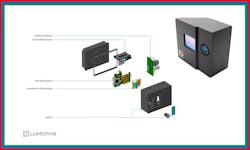Open platforms promise to revolutionize 3D sensing
The global three-dimensional (3D) sensing and imaging market is expected to grow from $10.94 billion in 2024 to $20.97 billion by 2029, according to recent market analysis from Mordor Intelligence,1 at a compound annual growth rate of 13.92%. This rapid growth is driven by increased demand across a variety of sectors, with North America expected to hold the largest market share, and the Asia-Pacific region emerging as the fastest-growing market.
These trends highlight the escalating need for advanced 3D sensing technologies, which are crucial for applications ranging from robotic navigation and obstacle detection to precise object recognition in industrial automation and autonomous vehicles. The ability to gather accurate real-time data through adaptable 3D sensing systems is quickly becoming a competitive advantage in these evolving industries.
As these markets expand, traditional light detection and ranging (LiDAR) systems are struggling to meet the demand for faster, more adaptable solutions. To stay competitive, industries must adopt modular technologies that offer quicker development cycles and greater flexibility to handle the increasing complexity and demands of modern automation systems.
Limitations of traditional 3D sensing
The development of 3D sensing systems has been fraught with challenges. Mechanical LiDAR solutions, for example, rely on bulky and fragile components that are prone to wear and tear, which results in compromised long-term reliability. Lengthy development cycles—often spanning several years—also make it difficult for companies to stay ahead of market demands.
Another key issue is the limited flexibility of existing systems. Many traditional solutions are either one-size-fits-all or require expensive, time-consuming customizations to meet specific needs. This lack of adaptability creates a significant hurdle for industries that need to rapidly deploy advanced 3D sensing technologies within a fast-paced market environment.
Promise of open platforms
In response to these challenges, modular platforms are poised to revolutionize the 3D sensing arena. One example is Lumotive's open development platform (ODP), which allows developers to configure and customize their systems in a manner similar to camera modules. By selecting components that best suit specific applications—whether in automotive, industrial automation, or service robotics—developers can tailor solutions to meet precise needs.
Using a modular design can significantly cut the pre-development process—reducing it from years to as little as three to six months. By supporting open platform configurations of components such as lasers, time-of-flight (ToF) sensors, optics, processors, and interfaces, these platforms provide the flexibility required to adapt systems to industry-specific demands.
Central to this approach is the integration of advanced capabilities, such as metamaterial-based technologies. Lumotive's light control metasurface (LCM) technology, which uses their LM10 beam-steering chip, is an example. This technology replaces fragile mechanical components with solid-state programmable optics. By using subwavelength structures to precisely control light, LCM enables real-time manipulation to overcome the limitations of traditional mechanical systems and provide the precision necessary for high-performance 3D sensing.
Harnessing metamaterials
Unlike traditional methods, and even newer solutions such as microelectromechanical systems (MEMS) or phased arrays, metamaterials offer enhanced control over light's direction and focus via subwavelength structures. This shift enables solid-state, programmable optics to replace the less capable components traditionally used in LiDAR systems.
Metasurfaces manipulate light in innovative new ways, allowing for ultraprecise, real-time control. This makes them ideal for advanced 3D sensing applications across various industries.
The LM10 beam-steering chip facilitates the creation of software-defined optical systems, which enables dynamic adjustments to functions such as range, resolution, and field-of-view. This adaptability improves both accuracy in object recognition and the reliability required for high-demand industrial environments where precision and consistency are critical.
Real-world applications
The versatility of open development platforms, combined with advances in metamaterials, is reshaping industries reliant on high-performance 3D sensing systems. Key markets stand to benefit significantly from this new approach:
Automotive. The drive toward autonomous vehicles demands reliable and customizable 3D sensing systems. Open platforms enable manufacturers to develop tailored LiDAR systems that enhance object detection and safety across diverse driving conditions. Adjusting parameters like range and field-of-view allows vehicles to navigate complex environments more effectively.
Industrial automation. Robots and drones in factories and warehouses require adaptable 3D sensing systems to handle intricate layouts and changing conditions. Modular solutions allow companies to quickly develop systems that offer precise navigation and object recognition to boost productivity and safety.
Service robotics. In healthcare, hospitality, and customer service, robots must interact safely with humans, which necessitates precise, dynamic sensing capabilities. Flexible platforms enable developers to create custom solutions with high-resolution sensing and real-time responsiveness—to ensure safe operation within sensitive environments.
Surveillance and security. Accurate object detection and tracking are critical for security applications. Open development platforms allow rapid development of 3D sensing systems customized for specific surveillance scenarios to enhance overall security measures through precise monitoring and reduced false alarms.
Driving the future of 3D sensing
The evolution of 3D sensing is entering a new era, driven by modular platforms that offer flexibility, scalability, and the ability to adapt quickly to market demands. Metamaterial-based technologies, such as those that use dynamic light control, are reshaping industries by replacing outdated mechanical systems with advanced programmable optics.
As automation and AI continue to accelerate across sectors like automotive and robotics, companies that adopt these modular solutions will be well-positioned to innovate and lead within the rapidly evolving landscape of 3D sensing.
REFERENCE
About the Author
Raj Kulkarni
Raj Kulkarni is the vice president of product and marketing for Lumotive (Redmond, WA). He has 25 years of experience in product development and strategy, and holds both a BSEE and MSEE in electrical engineering from Virginia Tech.

